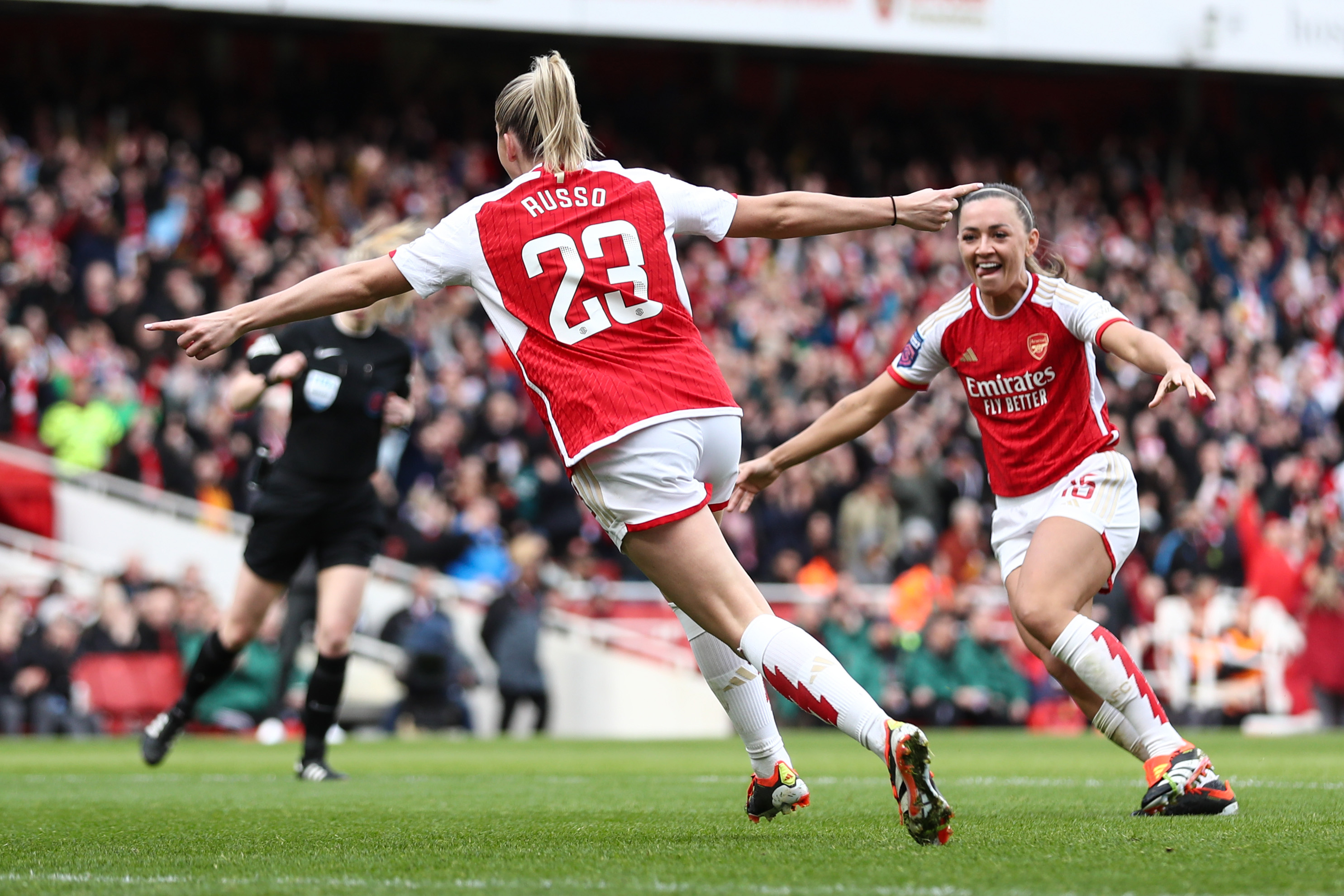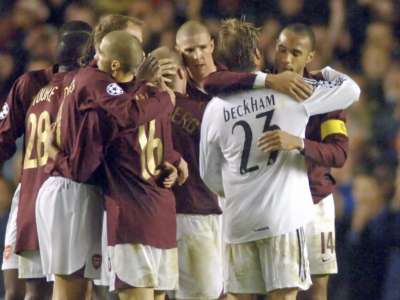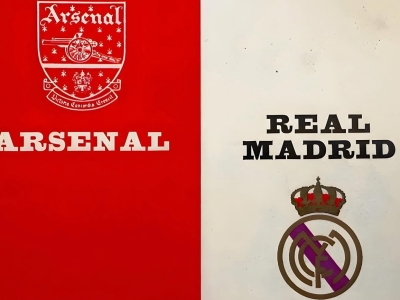Underperforming Arsenal
As Chelsea and Manchester City once again took the battle for the Women’s Super League to the final day of the season, Arsenal were faced with another final day fixture that held no sway in the destination of the WSL trophy.
As the Gunners took on Brighton at Meadow Park, the league title was being competed for by two sides who ended the campaign five points clear of Arsenal. Chelsea took the title on goal difference, a fifth in a row under outgoing manager Emma Hayes.
The previous season, Arsenal were again at home on the final day with nothing to play for, losing to Aston Villa and finishing a whole nine points behind Manchester United in second, let alone champions Chelsea.
Whereas 2022/23 was a case of pride and determination amidst a season of injuries to Arsenal’s key players- the Gunners reached the semi-finals of the Champions League and won the Conti Cup- the following season failed to meet the rightly-held high expectations of those at the club, and its loyal supporters.
Starting with a stutter
As this piece is focusing on the WSL, details of Arsenal’s early-season exit from the Champions League can be spared, but a penalty shootout defeat to Paris FC merely a few weeks after the conclusion of the World Cup in Australia and New Zealand was clearly not the curtain raiser to the 2023/24 campaign Arsenal had hoped for.
Any melancholy feelings from Arsenal’s Champions League exit were only made worse when the Gunners were defeated 1-0 by Liverpool on the opening day of the league season. "Are we performing at the level we want to right now? No we're not. We need to be better. There's no hiding from that,” said Jonas Eidevall.
Consecutive losses against Manchester United and Aston Villa were only saved by late comebacks (take a bow Cloé Lacasse and Alessia Russo), and the season only seemed to really get going when Manchester City were defeated 2-1 at Meadow Park.
Another remarkable comeback followed against Leicester City, when six second half goals overturned the Foxes’ 2-0 half-time lead. Wins over Brighton and West Ham set up one of Arsenal’s finest victories in recent years, thrashing Chelsea 4-1 at Emirates Stadium.
The quest for consistency
Arsenal tore Chelsea apart at the Emirates in December on a day where everything went right for the Gunners. Free-flowing build-up play created fantastic goals for Alessia Russo and Beth Mead, and Arsenal never gave Chelsea a look-in after their early equaliser. The better team won by a country mile- not my words, Emma Hayes’s.
Less than a week later, Arsenal were beaten 1-0 at the Tottenham Hotspur Stadium as their title hopes took another blow. Spurs have improved markedly under Robert Vilahamn, but this remained a game that Arsenal should have won.
Such toothlessness in front of goal just six days after scoring four against the champions seemed to epitomise Arsenal’s 23/24 campaign.
Usurped by the underdogs
Whereas 2022/23 saw Arsenal defeated by Chelsea, Manchester City and Manchester United in the league, the following season saw Arsenal go toe to toe with the stronger sides and drop points against those below them in the table.
Arsenal responded well to the Tottenham loss, winning every game in all competitions in January, but were then beaten 2-1 by West Ham in a game where everything went against the Gunners.
Viv Asseyi gave the Irons the lead from a wrongly-given penalty, but Manu Zinsberger’s failure to claim a free-kick opened the door for Hawa Cissoko to score West Ham’s second, after Steph Catley had put Arsenal in front towards the end of the first half.
Cissoko inspired West Ham’s defence to shut out Arsenal in the second 45, and again the Gunners were too hesitant in and around the box to threaten Rehanne Skinner’s side.
Losing to Liverpool, Spurs and West Ham does prove the increased competitiveness of the WSL, indeed, Liverpool finished in fourth, but Arsenal’s improved ability to go toe to toe with the stronger sides seemed to come at the cost of consistently struggling against low blocks and conceding sloppy goals.
A decisive defeat at Stamford Bridge
With the exception of Kim Little’s late consolation, this was a night where everything went wrong for Arsenal. After kick-off was delayed due to Arsenal bringing the wrong coloured socks to West London, the Gunners, sporting Chelsea’s socks, found themselves 3-0 down in 32 minutes at the mercy of Lauren James and Sjoeke Nusken.
Arsenal’s fans never stopped singing in the Shed End, but those in red on the pitch let their heads drop and Arsenal’s body language was that of a side who knew that their title hopes were likely over.
The Conti Cup final win over the same opposition was made more impressive by this loss, as Arsenal readjusted their tactics to claim silverware.
Ending on a high
Arsenal won five from their last six WSL games, conceding late on away to Everton in a frustrating display at the end of April.
The Gunners ultimately helped Hayes and Chelsea win the title when Stina Blackstenius scored a late brace at Manchester City to complete yet another dramatic comeback- another result that signified how Arsenal are able to compete with the best of the best in the division.
5-0 wins over Bristol City and Brighton & Hove Albion and a 3-0 victory against Leicester displayed improvements in Arsenal’s all-round performances, and some more attacking fluidity that the Gunners had been craving. Arsenal would finish third in the WSL, having notably scored 18 fewer goals than Chelsea and eight less than City.
The positives
Arsenal often found themselves in some difficult positions, but were able to win four of the seven WSL games in which they conceded first. Fans of clichés saw far too many games of two halves, where Arsenal would flatter to deceive before half-time only to hit top form in the second half and take home three points.
Alessia Russo’s improvement throughout the season was certainly a positive, with the England striker involved in 16 goals in the WSL. Fellow new signings Cloe Lacasse, Amanda Ilestedt, Laia Codina and Kyra Cooney-Cross all settled quickly and impressed in different ways, but Russo was the standout summer 2023 arrival.
Goalkeeper Manu Zinsberger also improved her game, under pressure from the capable Sabrina D’Angelo (who has now left the club), making the number one spot her own and signing a new contract.
Let’s not forget about January signing Emily Fox, who has already helped Arsenal go to a different level in attack with her intelligent forward runs. The Gunners will be pleased to have Laura Wienroither back in action, but she will have to work hard to displace the excellent Fox.
Improvement against the best teams in the league, as previously discussed, will bode well for next season, particularly if Arsenal can get back into the Champions League group stage. Jonas Eidevall was able to get his tactics right on the big occasions, outclassing Chelsea, Man City and Man United on different occasions and helping Arsenal claim the Conti Cup.
Areas to improve
The second half of the season saw Arsenal forced into finding new ways to break down low blocks, a tactical formula that proved to be Jonas Eidevall’s kryptonite. More variety in attack, and Alessia Russo’s improved positioning upfront, proved that Arsenal could score goals at will. The potential arrival of Mariona Caldentey from Barcelona will help Arsenal’s attacking versatility and bring trophy-winning experience to North London.
During Arsenal’s injury-laden 2022/23 campaign, the Gunners stocked up on midfield options, but now find themselves with arguably too many players who can feature in the middle of the park. Fitting Victoria Pelova, Kim Little, Frida Maanum, Kyra Cooney-Cross, Lia Walti (and the returning Kathrine Kuhl) into midfield has meant for constant rotation from Jonas Eidevall, who has often chopped and changed his number ten. Caldentey’s arrival could only worsen his selection headaches. A nice problem to have, but does the Arsenal boss know his best midfield?
On the wings, Eidevall will be tasked with getting the best out of his wide players. Caitlin Foord showed glimpses of her best form, particularly when she played in tandem with Steph Catley, but was often kept quiet by the opposition right-back. Foord was rarely afforded a rest though, with Eidevall turning to the likes of Cloe Lacasse less than was perhaps merited. Beth Mead has also returned well from her Anterior Cruciate Ligament injury, but Arsenal’s wingers have more to give.
Finally, Arsenal have to get back to finding consistency. The only way to win titles is to win games, and four defeats in a league season will not win a team the WSL. Jonas Eidevall’s side looked unstoppable at their best in 2023/24, but there was not a more frustrating side to watch when they were at their lowest. More defeats next season will put Eidevall under severe pressure in what is now his fourth campaign in charge.








